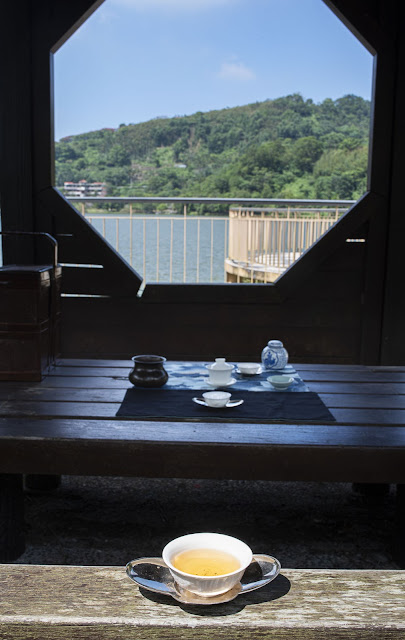The presence of the pond next to the plantation is also an advantage. The water cools down its surroundings. We can feel the cooling breeze in this covered resting place next to pond. Even at the end of September, it's too hot to stay in the sun. That's why I set up my blue dragon Chaxi in the shade. First, we had the charcoal Hong Shui Oolong from Yong Lung, the village north east of this spot..
I use an ivory white porcelain set, because it's a better fit for these two Oolongs. The porcelain gaiwan is the universal brewing vessel, because it's neutral to the aromas.
Let's go back to this Concubine Oolong from Dong Ding. It reminds me of the first time I introduced Guei Fei, Concubine Oolong on my blog. As you may see from the leaves and the brew, the oxidation was quite light (compared to Oriental Beauty). The harvest of the leaves was June 5th 2024, still early in the summer season. So, the temperatures aren't very high, yet, and this explains the relatively light oxidation level. Of course, the oxidation level also depends on what the tea producer aims to produce. Since Concubine Oolong is still loosely defined, the oxidation level can still vary from one producer to another. The same goes for the roasting level. By the way, the first time I tasted this tea, the farmer had only dried it. It tasted too raw, kind of astringent and I suggested that he should roast it. He agreed with me and the next time I visited him, I liked it so much that I've added it to my selection!
So, it's much lighter than the OB and the other Concubine Oolongs in my boutique, but it shines with its fresh bouquet and light aromas of honey and summer fruits. The taste is very alive, but has this Dong Ding thick fruity taste that lingers nicely in the throat. The ensuing salivation is first slightly bitter then sweet.
Enjoying this tea in its home terroir, just after the charcoal Hung Shui. These two teas both reflect the character and aromas floating in Dong Ding, but each shows a facet of the evolution of Dong Ding in spring. The later aromas are fruitier. But both have this deep, powerful taste from Dong Ding, which is very different than the light, energetic freshness of high mountain Oolongs. Apparently, this kind of taste is a taste for old guys. Hey! I still feel very young at 53! Especially when I drink a delicious Oolong tea outdoors!
Below, you can see the plantation where this Concubine Oolong comes from. It's the plantation located above the banana trees, not the one below. It's a very small, family managed tea garden and the nice thing is that it's surrounded by trees on each side.








.jpg)






No comments:
Post a Comment